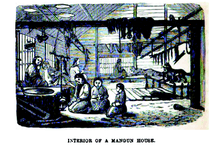Ulch people
| Total population | |
|---|---|
| (2,913 (est. 2002)) | |
| Regions with significant populations | |
| 2,765[1] | |
| 76[2] | |
| Languages | |
| Ulch language, Russian | |
| Religion | |
| Shamanism, Russian Orthodoxy | |
| Related ethnic groups | |
| Ainu, Orok, Itelmen, Evenki, Negidals, Nanai, Udege | |
The Ulch (Russian: ульчи, obsolete ольчи; self designation: нани, nani) are an indigenous people of the Russian Far East who speak a Tungusic language, Ulch. Over 90% of Ulchis live in Ulchsky District of Khabarovsk Krai, Russia. According to the 2002 Census, there were 2,913 Ulchs living in Russia — down from 3,173 recorded in the 1989 Census, but up from 2,494 recorded in the 1979 Census, and 2,410 recorded in the 1970 Census. According to the 2010 Census there were 2,765 Ulchs in Russia.

Interior of a Mangun House, drawing by Richard Maack ca. 1854-1860
| History of the Priamurye region (also including Heilongjiang, Amur Oblast and southern part of Khabarovsk Krai) |
|---|
| Sushen |
| Mohe • Shiwei |
| Balhae |
| Khitan |
| Liao dynasty • Daurs |
| Jin dynasty (1115–1234) • Nivkh |
| Eastern Jin (1215–1234) |
| Yuan dynasty • Evenks |
| Yeren Jurchens • Solon Khanate |
| Qing dynasty • Nanais • Ulchs |
| Russian Exploration • Negidals |
| Manchus–Cossacks wars (1652–1689) |
| Nerchinsk |
| Government-General of Eastern Siberia |
| Aigun |
| Li–Lobanov Treaty |
| Siberian Regional Government |
| Far Eastern Republic |
| Far Eastern Oblast |
| Soviet invasion of Manchuria (1945) |
| Sino-Soviet border conflict |
| Far Eastern Federal District |
Anthropologically, no clear racial groups exist. Some of them belong to the so-called Sakhalin-Amur group, like the Nivkhs.
References
| Wikimedia Commons has media related to Ulch people. |
This article is issued from Wikipedia - version of the 8/28/2015. The text is available under the Creative Commons Attribution/Share Alike but additional terms may apply for the media files.